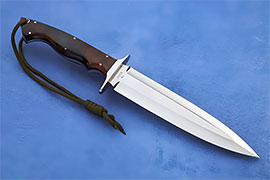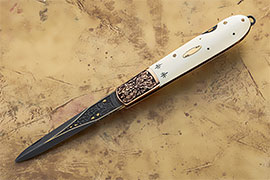Collecting vintage knives is more than just a hobby; it’s a passion for history, craftsmanship, and the unique stories each knife holds. Vintage knives, whether military, hunting, or custom-made, are revered by collectors for their exceptional design and the skilled artistry of their creators. However, in a market filled with reproductions, counterfeit knives, and altered pieces, finding authentic vintage knives can be challenging. To help you navigate the market, this guide will provide insights into how to spot genuine vintage knives and why choosing a trusted dealer like KnifeLegends is essential for building a quality collection.
In order to make sure we are all thinking of the same thing when we discuss Vintage Knives it’s essential to define a few important terms.
Generally speaking, an art knife that is not more than 25 years old is considered Contemporary.
An art knife that is between 25 and 50 years old would be considered Vintage.
An Art Knife between 50 and 75 years old would be considered Semi-antique and an art knife older than 75 years would be considered Antique.
The Allure of Rare Vintage Knife Collecting
Vintage knife collecting has seen growing popularity due to the rarity, beauty, and historical significance of these blades. Whether you’re interested in military-issued combat knives, pocket knives from the 19th century, or custom-forged hunting knives, vintage knives are treasured by collectors for their quality and durability. Owning an authentic vintage knife means you hold a piece of history that has survived the test of time, reflecting the craftsmanship and technology of a bygone era.
As with any valuable collectible, authenticity is key. An original, well-preserved knife can fetch a high price on the collector’s market, while replicas or altered knives hold far less value. The challenge for collectors, especially beginners, is understanding how to verify the authenticity of vintage knives in an online market filled with imitations.
Tips for Spotting Authentic Vintage Knives for Sale
Knowing how to spot authentic vintage knives requires careful observation and a keen understanding of what makes a knife genuine. Here are some tips to help you identify authentic vintage knives when shopping online:
1. Examine the Knife’s Markings
One of the easiest ways to verify the authenticity of a vintage knife is by examining the maker’s markings. Most high-quality vintage knives will have a stamp or engraving from the manufacturer on the blade or handle. These markings can include the knife maker’s name, logo, and sometimes a model number. Be familiar with how these marks have evolved over time, as counterfeiters often try to replicate them inaccurately.
Check for consistency in the stamp’s font, size, and location on the knife. If the marking looks off—too new, too clean, or uneven—it might be a red flag. Authentic knives usually show natural wear and fading over time, and their markings should reflect this.
2. Look at the Knife’s Construction Materials
Authentic vintage knives were made using materials that were standard in their era. For instance, many older knives have carbon steel blades, wooden or bone handles, and brass fittings. Pay close attention to these materials and compare them to what’s known about the knife’s period. Modern reproductions might use stainless steel or synthetic handles, which are giveaways that the knife is not original.
The quality of the blade’s edge and handle are also important indicators. Vintage knives that were used but well-maintained will show a patina or wear, but not excessive rust or obvious replacement parts. Any evidence of modern materials or techniques should be examined closely, as they may indicate restoration work or reproduction.
3. Check the Knife’s Condition and Patina
The condition of a vintage knife can reveal a lot about its authenticity. While some wear and tear is normal, especially on older blades, be wary of knives that appear too pristine. A knife that has been heavily restored may lose its value, especially if it’s been polished or sharpened excessively. Look for a natural patina on both the blade and handle. Patina refers to the dull, dark finish that forms on metal surfaces over time and is a good sign that the knife is truly vintage.
However, be cautious of knives that show too much wear. A knife that is rusted beyond repair, has cracks in the handle, or has been modified with non-original parts will have its value diminished. Aim for a balance: a knife that shows signs of age but is still structurally sound.
4. Research the Knife’s Origin
Before making a purchase, do thorough research on the knife’s maker, model, and history. Vintage knives that are well-known, such as those from Case, Buck, or Randall, often have extensive documentation, making it easier to verify their authenticity. Search for original catalog images, knife reviews, or expert opinions online to compare the knife in question with known authentic examples.
For military knives, researching the specific model and its historical context is crucial. Many military knives will have markings or designs specific to certain periods or branches of service, and verifying these details can be a strong indicator of authenticity.
5. Beware of Counterfeits and Restorations
Counterfeits and heavily restored knives can be tricky to spot, especially for novice collectors. Some forgers will use vintage components mixed with modern parts to create convincing reproductions. Others may heavily restore a knife, replacing blades or handles, and try to pass it off as original. When in doubt, ask the seller for additional details, photos, and proof of authenticity.
Restorations aren’t always bad, but the value of a restored knife will be less than one that’s in its original condition. When buying online, always inquire about any repairs or modifications the knife has undergone.
Why Choosing the Right Vintage Knife Dealer Matters
When buying vintage knives, especially online, choosing a reputable dealer is critical. A trustworthy dealer will provide clear descriptions, detailed photos, and, most importantly, a guarantee of authenticity. Working with a well-established dealer like KnifeLegends ensures that you’re buying knives that have been thoroughly vetted and are genuinely vintage.
At KnifeLegends, we specialize in offering rare and authentic vintage knives to collectors. We understand the intricacies of vintage knife collecting, from identifying authentic pieces to preserving their value. By sourcing only the highest-quality knives and providing expert advice, we make sure our customers are confident in their purchases.
Spotting authentic vintage knives requires a combination of knowledge, attention to detail, and trust in the seller. By examining the knife’s markings, materials, condition, and origin, you can better identify genuine vintage knives and avoid counterfeit or altered pieces.
When you’re ready to invest in authentic vintage knives, trust KnifeLegends. Our reputation for quality, expertise, and customer satisfaction ensures that you’ll find the right vintage knife to add to your collection. Contact us today to explore our selection of rare and authentic vintage knives.


